Mark Sisson's Blog, page 348
February 18, 2013
Dear Mark: Ravenous Freshman, Lipopolysaccharides, Himalayan Salt, and Squid
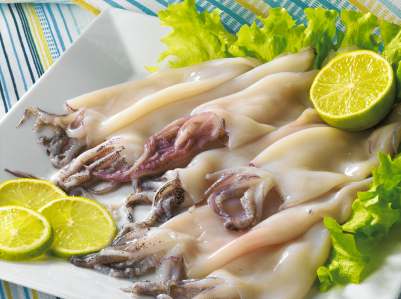 For today’s edition of Dear Mark, I’ll be covering four topics. First, I discuss a worrisome, troubling species: the ravenous college freshman. Is it a problem? Should this beast be culled or somehow reigned in? Next up are lipopolysaccharides, specifically the LPS that seem to arise in response to high-fat foods. Should we be worried? After that, I explore whether or not we should be switching out our normal salts for fancy pink Himalayan salt. Finally, I cover a question from a fish-hating reader who loves squid. Fish and bivalves seem to get all the love in the media and even in our community, but what about the cephalopods? How do they stack up as a replacement?
For today’s edition of Dear Mark, I’ll be covering four topics. First, I discuss a worrisome, troubling species: the ravenous college freshman. Is it a problem? Should this beast be culled or somehow reigned in? Next up are lipopolysaccharides, specifically the LPS that seem to arise in response to high-fat foods. Should we be worried? After that, I explore whether or not we should be switching out our normal salts for fancy pink Himalayan salt. Finally, I cover a question from a fish-hating reader who loves squid. Fish and bivalves seem to get all the love in the media and even in our community, but what about the cephalopods? How do they stack up as a replacement?
Let’s go:
Hi there,
My slender son is a freshman in college and came home for Christmas informing us that he is following the Primal [Blueprint] diet. While l have read many of the links on this site and think this makes sense, l am having a hard time getting my son to understand portion control. I have a family of five, and l can’t afford his eating habits! Yesterday I made a 19 pound turkey, since he ate most of our bird on Christmas. I came home from work today and he ate half the bird as well as the 6 sweet potatoes I boiled and mashed. This was supposed to feed us all. He is eating bags of oranges, grapes, almonds and pounds of protein at one sitting. This seems gluttonous to me! I have had to go grocery shopping every day since he’s been home. He is never full! He was always a slow eater before this and often left a plate unfinished. I can’t believe eating mass quantities of food is healthy for him! Please help me understand your portion recommendations!
Donna
This sounds pretty normal to me. It sounds like your son’s body has realized that real, actual nutrition is available and near, and he’s simply making up for all the lost years of not eating enough.
Don’t worry too much, especially if he isn’t gaining too much fat. Since he was “slender,” he probably could stand to gain some weight anyway. Also, try to resist assigning morality to one’s eating. Gluttony may have gotten that one guy in Seven killed (and even that was at the hand’s of a deranged, misguided lunatic), but in your son’s case, he’s just listening to what his body is telling him to do. The financial thing is understandable. Once he’s back at school, though, shouldn’t he have access to the dining halls? Those tend to be buffet-style, all-you-can-eat, so he’ll be getting his (your?) money’s worth.
Once his nutrient stores have been topped off, he stops growing, and/or his metabolism stops being superhuman, I imagine he’ll reduce his portion size.
But, man – he ate over nine pounds of turkey (well, I guess he didn’t eat the bones) and six sweet potatoes? Multiple bags of fruit and nuts at every meal? That’s just impressive. To be 19 and growing and hungry all the time is a special time in a young man’s life. Don’t begrudge him it. Let him continue.
Dear Mark,
Recently the Human Food Project, which you promoted, seemed to fire a shot over the bow of paleo eaters in warning that a high fat diet has been shown in many studies to increase LPS levels (lipopolysaccharides) causing inflammation and a whole range of diseases that we paleo eaters think we’re on the best track to avoid. They described however that this increase can be mitigated by a well cultivated microbiome (specifically, high levels of the species Bifidobacterium). As a result they recommended eating lots of onions and garlic which have been shown to grow these helpful bacteria. Now I think most paleo eaters know they should be eating some onions and garlic, but are we playing with fire here? Do we need to make sure we’re getting some of these everyday as well as eating a range of fermented foods or else the whole approach results in disaster? Is getting inflammation markers tested on a regular basis the only way to really be sure that a high fat diet is ok for an individual?
Thanks!
Doug
I’m not too worried about for several reasons:
Being Primal eaters, you guys are already eating lots of prebiotic foods, the soluble, fermentable fibers to which the Human Food Project is referring and which protect and nourish the gut and promote a healthy biome. And if you aren’t, then maybe you should start eating them.
Being Primal eaters, you guys are eating all sorts of other plant foods which may modify the LPS response to food. Oranges (their juice, to be specific), for example, have been shown to reduce LPS when added to fat-rich, carb-rich meals.
Being Primal, you guys are getting plenty of regular exercise, or even just frequent slow moving. Physical activity reduces circulating levels of LPS and down regulates the production of TNF-α.
What’s the takeaway here? Eat food, including plenty of plants, some fibrous, some orange. Get your exercise. In short, this is just confirmation that true health and wellness depends on a host of lifestyle factors – not just what you eat. Changing your food isn’t enough.
Some espouse health benefits of consuming some Himalayan salt sole the first thing in the morning. Presumably, it also provides some beneficial minerals. How many mgs of salt does it eat up our daily allowance and is it worth it?
Also, is it a better choice when salt is desired for seasoning?
Tnx,
John
Pink Himalayan salt does have some (lots of) minerals, but they’re pretty much only present in trace amounts. About 98-99% of the minerals will be plain old sodium chloride, or salt. You won’t get very much magnesium, calcium, iron, iodine, or anything else out of it. That’s not to say it’s useless and that you should use iodized table salt. I’m just extremely skeptical of any of the amazing health benefits.
Some do find it helpful to take a nice whack of salt in the morning. As I mentioned in a recent post, salt levels are depleted in times of stress, and adding salt as a standalone supplement can provide a buffer. If you find yourself lacking energy or just feel somewhat off – and you haven’t been eating much salt – consider drinking some salt water or eating a really salty breakfast. I’m not sure the Himalayan salt is the crucial factor here, though. Whatever salt you use, you’ll be getting the vast majority of your dietary minerals from the foods you eat. Trying to get them through pink salt will be impossible (and pretty disgusting).
I will say that the colored, unrefined salts have more interesting flavors and textures than plain salt. Nothing like adding a few pinches of pink salt crystals to sautéed green beans that give a little crunch with every bite.
Dear Mark,
I must first off say a BIG thank you to you for all your hard work and free information on this site, seldom are worthwile things free anymore. I must also thank you for your book and all the gems contained there in, it has helped me so much with my goals of eating healthy for life, rather than on off dieting and towards getting the lean, strong physique I desire. I look forward to reading your latest release when time permits. I just wanted to ask what are your thoughts on squid vs fish in terms of health benefits (omega 3s and all that good stuff). I have tried many many times to choke down fish because of the health benefits but I absolutely hate the taste. I love squid however, and would like to know if eating squid in place of fish is giving those same health benefits? Also if this is the case, how many times a week would you advise consuming squid? I have researched this myself but the information I found is a little vague and I knew I would be able to get the clear cut facts from you. Thank you again for all your tireless work and help.
Kind Regards
Craig
Adelaide, Australia.
Squid is fantastic. Although its tentacled appearance can be unsettling for people, it’s actually an extremely mild, adaptable, nutritious source of marine protein that looks relatively innocuous in ring form. It’s chewy (very much so when cooked incorrectly) and works well with any flavor profile I’ve ever tried to throw at it.
As for the omega-3 content, it’s not quite a “fatty” fish on the level of salmon or sardines, but a four ounce portion of raw squid contains over half a gram of omega-3s. If you’re keeping omega-6s low, you really don’t need massive amounts of omega-3s, so squid can fill in quite nicely. Plus, we don’t just eat seafood for the fats. The sea minerals are also important, and squid is a very rich source of selenium and copper (PDF) – two vital nutrients for cardiovascular and thyroid health. Squid is also pretty high in cholesterol, which some may balk at, but I wouldn’t, especially if you’re trying to get stronger. Steroid hormones are synthesized from cholesterol, and one study showed that increased dietary cholesterol translated to strength gains during weight training.
Keep an eye out for squid ink, too. One study found that feeding it to chickens increased their performance and improved their antioxidant capacity (PDF).
Eat the heck out of your squid. Just don’t turn it into seed oil-fried calamari dipped in seed oil mayo. I also wouldn’t try choking down the fish. Keep searching for a fish that doesn’t offend, but don’t force yourself. I’m of the opinion that regularly feeding yourself something that physically repulses you is bound to increase stress and be counterproductive in the long run.
That’s it for today, guys. Be sure to leave a comment and thanks for reading!
Get All Three Primal Cookbooks, an Apron and More in The Primal Blueprint Chef Kit Today!

February 17, 2013
Weekend Link Love
 Research of the Week
Research of the WeekWhen energy expenditure is matched, “minimal intensity”, long-duration “walking and standing” had more beneficial effects on insulin action and blood lipids than “moderate to vigorous” cycling, according to a new study. Didn’t I tell you to move around a lot at a slow pace?
Exposure to “urban lighting” made birds reach sexual maturity faster. This study is highly interesting and relevant to our pursuit of health, but I was also happy to include the following quote: “City birds’ testicles were ready for action about 26 days earlier than those of their country-dwelling counterparts.”
Circulating levels of trans-palmitoleate, a fatty acid found in dairy – particularly grass-fed dairy – were associated with higher LDL but lower triglycerides, fasting insulin, blood pressure, and less diabetes. I know which bunch of biomarkers I’d rather have.
Interesting Blog Posts
How to train your mind to “scan” for the good stuff in our lives as a default, instead of the bad stuff. Also, something about Tetris.
Media, Schmedia
Does this article on barefoot horses sound eerily similar to anyone else?
In my new book The Primal Connection, I bemoan the fact that we no longer eat dirt. This guy has done something about that (albeit with pasteurized, homogenized dirt).
Everything Else
How do you feel about this picture of lotus seeds? If you suffer from trypophobia (which, from what I can tell, describes the “fear of holes with stuff inside them” and, according to some researchers, may have some evolutionary basis) you might be recoiling in disgust. I’m all for the evincing of disgust at the sight of a crumpet, but my only response to the inside of an uncleaned cantaloupe half is hunger.
Recipe Corner
“Maple blueberry bacon breakfast carnitas.” Try saying that five times fast while chewing your maple blueberry bacon breakfast carnitas.
Or, if you don’t have enough time for that, you can just make this super easy breakfast scramble. It’s also way easier to say five times fast.
Time Capsule
One year ago (Feb 17 – Feb 23)
Dear Mark: Should I Consume Caffeine Before My Workout? – Should you?
How Should Children Exercise? – Kids need to move, love to move, but what’s the “best” way for them to do it?
Comment of the Week
Wouldn’t this be funny to try to explain to our great-great-grandparents: “I have a device in my back pocket that can access the collective knowledge of all mankind. I use it to look at pictures of cats and get in arguments with people I don’t know.”
-Indeed. But let’s be honest: who doesn’t love cat pictures?
Get All Three Primal Cookbooks, an Apron and More in The Primal Blueprint Chef Kit Today!

February 16, 2013
Pork Chops in Creamy Turmeric Sauce
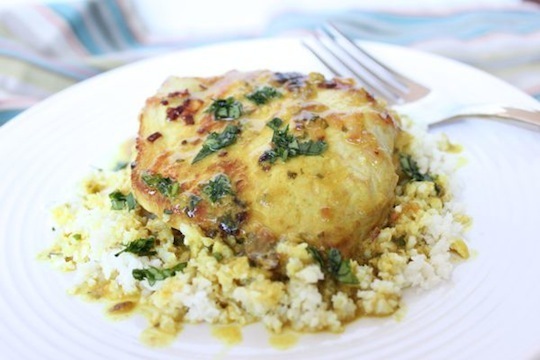
Pork Chops in Creamy Turmeric Sauce is a spicy (but not overly hot), sweet, tangy dish. It has complex flavor but very simple preparation. The sauce is also really versatile and likely to taste just as good over chicken, beef, or seafood. This is the type of recipe you’ll make again and again.
Turmeric lends its deep yellow color and the earthy, peppery flavor often tasted in curries. It also adds a slew of potential health benefits to your meal. Coconut milk, lime, cilantro and jalapeño are the other major flavors, coming together in a bold and plate-licking good sauce.
Pour the sauce over cauliflower rice, top it with a pork chop and then sauté or steam some veggies for a side. Dinner is served!
Serves: 4
Time in the Kitchen: 30 minutes
Ingredients:
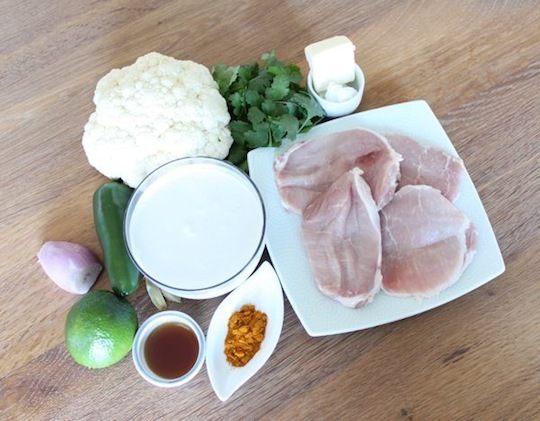
1 can (13.5 ounce) coconut milk (400 ml)
2 garlic cloves
2 tablespoons freshly squeezed lime juice (30 ml)
1 tablespoon fish sauce (found in the Asian section of grocery stores) (15 ml)
1 small jalapeno, roughly chopped (optional)
A handful of cilantro leaves
1 teaspoon turmeric, plus more to season pork (5 ml)
4 boneless pork cutlets or thin pork cops (1/2 inch thick or less) (13 mm)
1 tablespoon coconut oil (15 ml)
1 shallot, finely chopped
1 head of cauliflower
Salt, for seasoning
Butter, to flavor cauliflower rice
Instructions:
Combine the coconut milk, garlic, lime juice, fish sauce, jalapeno (optional),1 teaspoon turmeric, and the cilantro in a blender. Blend the mixture into a smooth sauce.
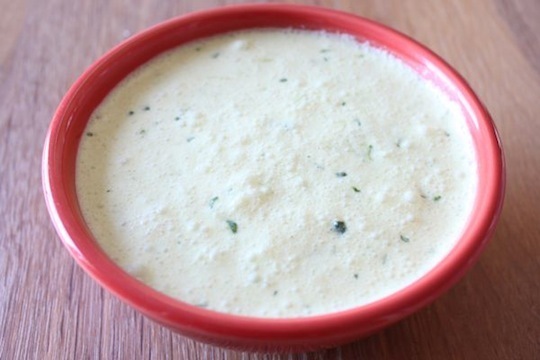
If the pork isn’t thin enough (1/2 inch thick or less) use a meat mallet to flatten the pork. Or, slice thicker pork chops in half to turn them into two thinner chops.
Lightly season the pork with salt and turmeric.
In a wide skillet heat the coconut oil. When the oil is hot add the shallot and saute for 30 seconds. Add the pork.
Cook the pork only 2 minutes on each side until lightly browned.
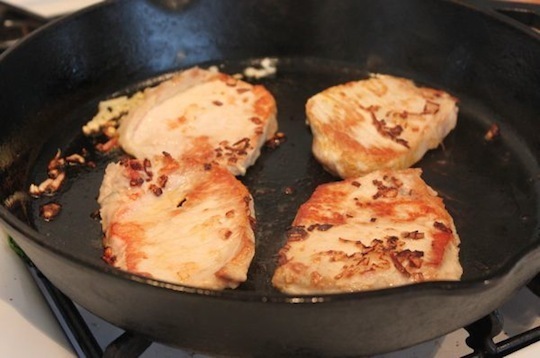
Transfer the pork to a plate.
Add the coconut sauce to the skillet. Use a spoon to scrape up any tasty bits of meat stuck to the pan as the sauce comes to a boil. Boil for 5 minutes.
While the sauce is boiling, make the cauliflower rice. Trim and roughly chop the cauliflower.

Process in a food processor until the cauliflower has the texture of rice (the cauliflower can also be grated by hand with a box grater).

Cauliflower rice can be cooked in a microwave for 3 to 5 minutes until soft or sautéed in a pan with several tablespoons of oil for 5 to 10 minutes until soft. Season with salt and butter.
Add the pork and any accumulated meat juice back to the skillet with the sauce. Simmer just long enough to heat the pork back up.
Serve the sauce and pork over the cauliflower rice. Garnish with additional chopped cilantro.

Get All Three Primal Cookbooks, an Apron and More in The Primal Blueprint Chef Kit Today!

February 15, 2013
I Feel Alive for the First Time in Years!
It’s Friday, everyone! And that means another Primal Blueprint Real Life Story from a Mark’s Daily Apple reader. If you have your own success story and would like to share it with me and the Mark’s Daily Apple community please contact me here. I’ll continue to publish these each Friday as long as they keep coming in. Thank you for reading!
 Mark,
Mark,
After one full year of Primal Living, I thought now was as good a time as any to share not only my story, but my thanks as well for where I am today.
I feel alive for the first time in years!
A friend of mine had been chirping in my ear for months about Primal/Paleo as well as her obsession with CrossFit. Her boundless energy and enthusiasm was a bit much at times, but it was nonetheless curious to me. I had spent the past few years living a high stress, sedentary, and depressed lifestyle which, looking back on now, was extremely unhealthy and setting me up for an early demise. It’s odd how easy it is to blind yourself to the unhealthy actions you take upon yourself without a conscious understanding of their effects. However, after a few emotional breakdowns and panic attacks that hit me in the latter half of 2011, my awareness became attuned to the dire emotional and physical situation I had put myself in.
So, on a whim I decided to ask my friend what she was talking about. In late December 2011, on a Saturday afternoon, she sent me straight to Mark’s Daily Apple. Five hours later, I realized I hadn’t stopped obsessively devouring everything I was reading on this site. I consider myself a fairly smart person, and as I finished reading each of the Definitive Guides, it was quite literally a face-palm moment of clarity; “This makes so much sense. How did I not understand this before now?!” Needless to say, the very next day, I decided to give this new way of life a try.
I’m 33 years old, 6’1”, and started the year at 322 lbs which was very near the heaviest I’ve ever been. I stopped weighing myself during that time, but I think I peaked around 330-340 earlier the previous year. The photo was taken last December.

On January 1, 2012, the only thing I changed at first was what I was eating. I eliminated all processed foods and grains and switched to healthy fats, meats, and veggies. I continued to work long days and lead a sedentary lifestyle. However, just changing the food I was eating yielded IMMEDIATE results. Within the first few days, I felt like I was no longer living in a fog – my mind was clear – and I found myself with newfound energy. I dropped four pounds the first week, four and a half the second, and another four pounds the week after that – and I didn’t feel like I was even trying! Talk about motivation! It turns out we really are what we eat! I furthered these efforts for a few more months, and saw continued and consistent weight loss, a lack of mood swings, and crazy amounts of newfound energy. In March I started jogging a bit following the Couch to 5K program, simply because I had to do something with all the energy I now found myself with.
Now a full year into my new lifestyle, I find myself 105 lbs lighter, with ALL of my previous health issues and risks eliminated completely. It’s enjoyable to see my doctor dumbfounded and in awe of my results. The second photo was taken just a few days ago, the little guy is my beautiful new nephew.

I’ve completed a 5K, a 10K, and have started training for a half marathon. Now that I’ve established a base, and felt the effects of healthy living, I need to focus more on a few of the finer points of Primal Living; lift more, play more, and (reluctantly) give up beer. I’m not quite where I want to be physically, but I’m well on my way to a long and healthy life as I continue to “Grok on!”
Thanks Mark, for simply making sense and dispensing it to the masses. I don’t know where I’d be today without having found this journey.
Andy
Grab a Copy of The Primal Connection and Take Control of Your Life Today!

February 14, 2013
13 Healthy Ways to Begin the Day
 In the midst of topical wound ointment, baby wearing, and gynoid fat, sometimes it’s nice to just back up and focus on the basics. How much more fundamental does it get really than getting up in the morning? I think we can safely count it as square one. Whether you’re stopping by today as a Primal newbie or old timer, most of us need the reminder at some point. Ah, morning. It’s an alternately grim and comical scene in most American households. There’s the snooze parade, rumpled faces, chronic grouchiness, catatonic showers, coffee frenzy, mad dashes, and neon colored breakfast with cartoon characters (fun prize included!). We’re quite a species to behold at 6:30 a.m. What can we do to change this picture? Is there such a thing as a Primal morning short of rising from a sleeping bag in a remote corner of mountain wilderness? You decide. A more approachable goal this morning might be this: what can make the morning feel – and be – a little healthier and happier?
In the midst of topical wound ointment, baby wearing, and gynoid fat, sometimes it’s nice to just back up and focus on the basics. How much more fundamental does it get really than getting up in the morning? I think we can safely count it as square one. Whether you’re stopping by today as a Primal newbie or old timer, most of us need the reminder at some point. Ah, morning. It’s an alternately grim and comical scene in most American households. There’s the snooze parade, rumpled faces, chronic grouchiness, catatonic showers, coffee frenzy, mad dashes, and neon colored breakfast with cartoon characters (fun prize included!). We’re quite a species to behold at 6:30 a.m. What can we do to change this picture? Is there such a thing as a Primal morning short of rising from a sleeping bag in a remote corner of mountain wilderness? You decide. A more approachable goal this morning might be this: what can make the morning feel – and be – a little healthier and happier?
Drink Water
I don’t buy the eight glasses a day commandment. I think water is overrated in fact. Nature gave us a sensation called thirst for a reason, and for most of us it tends to work pretty well. That said, after eight hours of total abstinence, your body could use the liquid. I see people down two to three cups of coffee, when they were probably more thirsty than insufficiently caffeinated. Maybe a productive rule would be this: water first, then coffee or tea if you want it.
Wake Up to Natural Light
Once again, reduce your dependence on caffeine by stimulating yourself biochemically with plan old light. Sunlight is ideal, but turn on the all the lamps (full spectrum bulbs are best) if you’re up before the sun. Unlike caffeine, there’s no impending energy crash waiting for you in a couple hours. If you can, use natural light to wake yourself with open curtains (unless outside artificial light will disturb your sleep at night) or a progressive light “alarm.”
Spend Fifteen Minutes (or More) Outdoors
Even if it’s pitch black when you roll out of bed, try to get some time in before you leave for the day or get sucked into your at-home household/work routine. Enjoy your breakfast outside, shovel the walk now rather than later, throw the ball for your dog, water your garden in your bathrobe (the neighbors can deal with it), or take a walk.
Move
For me, there’s just no substitute for a morning walk. It’s something I’ve come to appreciate over the years. Nothing wakes me up, relaxes me, and focuses my thinking in quite the same way. That said, any kind of movement can energize you naturally and boost your circulation. Who doesn’t want to begin the day with an endorphin rush? Getting your workout in first thing means you won’t be tempted to skip it later when a meeting runs late, you have an event to attend, or you just want to chill out at the end of the day. If you can’t bring yourself to workout or walk, do whatever you can: lunges while you brush your teeth, calf raises while you eat your breakfast, stretches while you wait for the shower to warm up. Anything will always be better than nothing.
Meditate
For some, it’s cultivating quiet composure on a favorite pillow. For others, it’s an invigorating yoga routine. It can be working with affirmations, prayers, relaxation techniques, or mindfulness exercises. However it works for you, you’ll begin the day with a biochemical advantage that will hold stress at bay more effectively.
Play
I know, I know. Morning minutes are precious. You don’t have time for fooling around. If you want to set a relaxed, creative path for the day, however, you’d do well to leave a little extra time for the wholly non-utilitarian. Rough house with the kids, play with your dog, do some doodling, or stop by the park on your morning run and hit the swings.
Enjoy a Good Primal Indulgence
Last week, so many of you weighed in on the need for non-destructive ways to “treat” ourselves in a healthy way. Everyone loves getting up in the morning when they know something good is waiting for them. We can use that pattern to our advantage. Do something that makes you feel good. Invest in a deluxe shower head or a luxurious robe. Put extra effort into making an amazing Primal breakfast. Get up early and take an honest-to-goodness bath once in a while.
Journal
Take the time to listen to yourself. There’s a reason productivity experts stress the importance of morning hours. We tend to have our best energy and clearest thinking during these hours. Do some writing therapy, and journal for ten minutes about a personal question or goal or taking inventory in a gratitude journal. An unencumbered mind might present unexpected insight.
Set the Inner Conversation
Even if you don’t have the time or inclination to journal, you can begin your day thinking on a positive and productive note. Skip the computer, TV, radio, and even the newspaper. Do you really need to start the day with news of 3,000 dead in an earthquake? There’s plenty of hours left to inform yourself. Instead of filling your head with the slew of random reports, feed yourself some good motivational nuggets. Whether it’s a daily quote, a brief chapter of your favorite health and wellness book, or some other encouraging source, take control of the thoughts that set the tone for your day.
Play Music
I’ve written about the power of music therapy. If it can get you through an operation with fewer pain meds, the right playlist just might help you get over the morning hump.
Sex
There. I said it.
Spend Meaningful Time with Loved Ones
Most people I know feel like they barely see their partners and families in the morning. It’s rushed, stressful, even agitated time. Don’t take the day – or them – for granted by accepting this as inevitable. You can all do better. Sit everyone down for a real breakfast or go for a morning walk together. Take time to cuddle and read with the kids before everyone gets dressed. If you live alone, meet a friend for coffee, or send a couple morning emails to your favorite people.
Follow a Simple Routine
This is really a “how” rather than a “what.” Do whatever you can the night before (make lunch, prepare breakfast ingredients, write the day’s agenda, choose clothes, unload the dishwasher, etc.) The more you do the night before, the more relaxing your morning can be – and the more time you’ll have for the stuff that really matters.
On that note, thanks for reading today, everybody! Share your own ideas for enjoying your morning and starting the day on a healthy note.
Grab a Copy of The Primal Connection: Follow Your Genetic Blueprint to Health and Happiness Today!

February 13, 2013
5 Things People Assume About Me That Are Wrong
 As Mark’s Daily Apple and the Primal community have grown in popularity, I hear a lot of stuff bandied about. Some of it is positive, some negative, and that’s to be expected. You can’t please everyone – I would probably be surprised if no one ever criticized me. However, I’ve noticed that for whatever reason, some people have a skewed perception of my opinion on certain issues. Maybe it’s my fault for not being more clear. Maybe they just haven’t plumbed the depths of MDA (I don’t blame them; it’s got some deep archives) to find the truth, instead going on what someone else told them. But whatever the reason, I have an obligation to set the record straight. I don’t want people getting the wrong idea about me or my ideas.
As Mark’s Daily Apple and the Primal community have grown in popularity, I hear a lot of stuff bandied about. Some of it is positive, some negative, and that’s to be expected. You can’t please everyone – I would probably be surprised if no one ever criticized me. However, I’ve noticed that for whatever reason, some people have a skewed perception of my opinion on certain issues. Maybe it’s my fault for not being more clear. Maybe they just haven’t plumbed the depths of MDA (I don’t blame them; it’s got some deep archives) to find the truth, instead going on what someone else told them. But whatever the reason, I have an obligation to set the record straight. I don’t want people getting the wrong idea about me or my ideas.
In this post, I’m going to describe five common misinterpretations about me and then explain where I truly stand. You may still disagree with me. That’s cool. At least then you’ll be able to criticize me for what I actually said or wrote.
So, what are some things people assume about me that are wrong?
That I support unlimited calories, endless grams of fat, and constant relentless gorging.
To my knowledge, I’ve never claimed that calories don’t matter (cue frantic searching of MDA archives). On the contrary, I’ve held that while calories are the ultimate arbiters of weight management, the beauty of a Primal eating plan is that obsessively counting, tabulating, graphing, and monitoring calorie intake often becomes unnecessary. You’re eating nutrient-dense and calorie-sparse plants, nutrient-dense animals (and their fat), and nutrient-dense and calorie-dense starchy plants (when desired/required), and you just need less food than before. You’re sated, you enjoy the food, you’re sufficiently nourished, and so you don’t eat as much. You’re not telling yourself not to eat X amount of calories; you just don’t get hungry for all those extra calories and so it’s not an issue that requires conscious thought. Some people may even find counting counterproductive to weight loss if the counting intrudes on their enjoyment of normal life and becomes a significant source of stress.
If you somehow find the will and desire to gorge endlessly on multiple thousands of calories of coconut oil and butter and red palm oil and mac nuts and grass-fed beef and wild-caught salmon, you can and likely will gain weight (and fat). All I’m saying is this: why would you ever want to? Calories do matter, though. I’ve always said that.
That I hate carbs in any form.
The reality is that I view carbs as an elective source of calories to be divvied out according to training volume, performance goals, and individual variation in tolerance/desire. If you’re regularly engaging in lots of anaerobic activity (HIIT, sprinting, heavy lifting, mid-to-high intensity endurance training, sports like soccer, basketball, football), you should probably eat more carbs to the tune of 100 extra grams per hour of anaerobic output. If you’re just doing lots of walking, lifting once or twice a week, and throwing in a sprint session every now and then, you’ll probably be fine underneath the Primal carb curve. I gear my recommendations toward regular folks getting regular, but not excessive or elite level, amounts of activity – the people who juggle work, family, sleep, and leisure with exercise. That’s me, that’s most of you, but it’s not everyone. If I come off as a carb basher, it’s only because I assume that most people aren’t doing the kind of activity that warrants carb-loading.
I am a big proponent of eating a macronutrient that works for you and your lifestyle and your needs, whatever those look like. I’m also a big proponent of gorging on in-season berries to the point of stomach upset (not really, but kinda). My point is that I don’t hate any and all carbs.
That I hate gyms.
I talk a lot about the benefits of being outside in nature, particularly being active outside in nature. I often suggest that people go for hikes on a weekly basis, preferably with family members (both hominidae and canid). I discuss spiritual encounters in nature, wherein people experience what seem like “mystical” states of mind simply by leaving city limits and rubbing up against some trees and greenery. I’ve explained how exercising outdoors is not only more effective, but also more sustainable – people are more likely to stick with an exercise plan when they do it outdoors. What wins?
Trail running through a forest of redwoods with the brilliant morning sun shimmering through the canopy overhead or jogging on a treadmill while watching close captioned American Idol?
Sprints on a beach (complete with adjacent natural sea salt cold dip wave pool) or sprints on a track?
Stand up paddle boarding on blue-green seas or, well, there isn’t really a gym equivalent to that one, is there?
I’ll always choose to workout outside if I can. Of course, I live in Malibu, where winter is when surfers wear hooded sweatshirts with their shorts and sandals, so I have the luxury of exercising outdoors year round. Many people do not. Perhaps my perspective is skewed.
That said, I like gyms. I work out in a gym on a regular basis. And bulky, oddly shaped natural objects like rocks and logs are fun to pick up and put down, and you can get really strong using them, but barbells, weight vests, kettlebells, and other manmade fitness tools are arguably better for building pure, raw strength. You know what? Make like Arnold and lug a barbell and some weights out to the forest and get the best of both worlds.
That I hate any and all forms of cardio.
One of my earliest and most popular posts was my tirade against chronic cardio, or the kind of extended mid-to-high intensity endurance training that made me sick, broke down my body, required me to eat an inflammatory diet laden with cheap refined carbs, destroyed my social life, and sapped my will to live. My terrible experience with high-level endurance training helped me find a more sustainable, more Primal path. It got me where I am today, basically. It was the impetus for my search for something better. I guess you could say I’m not a big fan.
I’ve become known for that stance on chronic cardio, but many people assume that distaste extends to all cardio. They assume I roll my eyes at people who ride their bikes to work, who run a 5k every now and then, who use the rower at the gym, who go hiking with heavy rucksacks, who swim laps. I don’t hate all cardio, though. I mean, how many times have you gotten annoyed with how often I tell people to walk, hike, and otherwise move around at a slow pace? That’s “cardio.” I fully support all forms of movement that result in improved health and happiness. I’ve mentioned before that my characterization of an activity as chronic cardio is more qualitative than quantitative. Rather than hewing to some objective standard, it often comes down to your subjective response. For me, running more than five miles or so becomes a race, even if I’m the only one around. I stop enjoying the run and start to focus on how fast I’m going, how far I’ve gone, and how much I can push it. I get sucked in to the competitive tunnel.
I’m not even against running the occasional marathon, if you truly enjoy it and it improves your quality of life. But training for marathons round the clock? Logging 15-20 miles a day? I can’t in good conscience recommend that people do that in the pursuit of good health. Do it to say you can. Do it because you love it. But don’t do it to live forever.
That I romanticize the hunter-gatherer existence.
I don’t romanticize anything (except, perhaps, grass-fed meat). I simply acknowledge the reality of our situation: humans, as a species, have evolved under various selective pressures and environments, and by studying those pressures and environments, we can learn about what lifestyle interventions might work for us, today, in the here and now. Moreover, we undoubtedly did not encounter 10-hour workdays consisting solely of sitting on our duffs, penned in by cubicle walls, isolated from our fellow humans (except by choice). We did not eat sugar, seed oil, and grain slurries out of colorful boxes and plastic packaging. It is a simple fact that some things about our modern existence are screwy and ridiculous, and when we spend our days sitting down, completely isolated from nature, from other humans (in the flesh), from edible plants and animals in their original packaging (absent some fur, perhaps), problems arise.
Our hunter-gatherer ancestors spent most of their lives outdoors. One wonders if perhaps spending time outdoors is therefore “normal” for our physiology and we should do it more often. Sure enough, recent scientific evidence shows that being outdoors confers numerous health benefits upon humans. Health benefits that we can verify with actual biomarkers.
Our hunter-gatherer ancestors got a decent amount of sunlight (being outdoors), depending on where in the world they lived. One wonders if perhaps sun exposure provides any benefit to modern humans. Sure enough, evidence suggests that vitamin D (which humans make from sun exposure) performs many physiological tasks, like immune modulation and bone calcium resorption, vital to our health. (Also, sunny days tend to make people happy, which counts for a lot.)
Our hunter-gatherer ancestors experienced high infant mortality. High infant mortality is not very good for human health.
Our hunter-gatherer ancestors did not have access to modern medical technology. Modern medical technology is good for human health.
Do I think we can gain valuable insight about what makes us tick and what works today by examining the ancestral environment? Yes, absolutely.
Am I happy to live in the 21st century where babies generally survive and people can hold all the world’s knowledge (and then some) in the palm of their hands and casually implore lightning to do their bidding with a flick of a switch? Heck yes.
To say that certain selective pressures helped determine the physiology of modern humans and that we can glean helpful and relevant lessons from studying (or even speculating about) said pressures is not to say that everything was perfect back then and we need to return to that perfect Edenic (that wasn’t) lifestyle. It’s just saying what it says. Nothing more.
What other misconceptions about me and my message have you seen out there? Lemme know in the comment section! Thanks for reading, folks.
Get All Three Primal Cookbooks, an Apron and More in The Primal Blueprint Chef Kit Today!

February 12, 2013
Is It Primal? – Popcorn, Corn Tortillas, Rye, and Other Foods Scrutinized
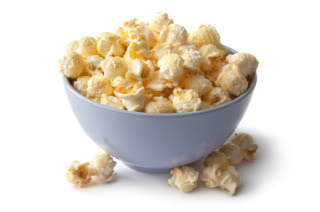 Every so often, people ask about foods that are clearly not Primal. While the more diehard among you might expect me to ignore and lambast these fine folks, I think this is the wrong tactic. We can’t have any sacred cows (except, perhaps, grass-fed ones) in this business; we must always be willing to examine our beliefs and explore “forbidden” foods. If some of them turn out to be not so bad – or even beneficial – we end up with even more choices. And that’s generally a good thing to have. Plus, even though most of the questionable foods may not end up getting “Primal approval,” at least we’ll be more informed and better prepared to make good choices when we decide to “stray” or cheat. Because cheating is going to happen. Because the 80/20 rule is a good rule to follow. Why not know what we’re getting into? Why not lean toward harm reduction, even as we eat something that isn’t exactly Primal?
Every so often, people ask about foods that are clearly not Primal. While the more diehard among you might expect me to ignore and lambast these fine folks, I think this is the wrong tactic. We can’t have any sacred cows (except, perhaps, grass-fed ones) in this business; we must always be willing to examine our beliefs and explore “forbidden” foods. If some of them turn out to be not so bad – or even beneficial – we end up with even more choices. And that’s generally a good thing to have. Plus, even though most of the questionable foods may not end up getting “Primal approval,” at least we’ll be more informed and better prepared to make good choices when we decide to “stray” or cheat. Because cheating is going to happen. Because the 80/20 rule is a good rule to follow. Why not know what we’re getting into? Why not lean toward harm reduction, even as we eat something that isn’t exactly Primal?
That’s ultimately what this ongoing series is all about.
Popcorn
It’s an American tradition, isn’t it? You fork over thirty bucks for a pair of movie tickets, trundle into the theater, and head directly to the concession stand for a gallon of Icee, some nachos, a box of Junior Mints, and a large buttered popcorn (with free refills). For many people, moviegoing just isn’t the same without the feed. As Primal Blueprinters, I’m sure you can handle yourselves at the cinema. The Icees, the nachos, the candies don’t really interest or tempt you – you’ve snuck in a BPA-free container of roasted lamb leg, after all – but the popcorn calls to you. For one, sometimes they use real butter as a topper. For two, most places still pop it in actual coconut oil. For three, it’s salty and, let’s face it, delicious.
Popcorn has gotten some press as of late as a great source of polyphenols. Problem is, all those antioxidants are located in the hull of the kernel, that brown, flaky carapace that gets lodged between teeth and embedded in throats. The hull is also made up of insoluble fiber, which can add bulk to your stool, but it’s not the most digestible nutrient around. If you’re not digesting it, are you really getting the popcorn phytonutrients?
Corn has phytic acid, which can chelate certain minerals in the gut and prevent your absorption of them. However, heat treatment of dried corn reduces phytic acid by up to 52%. Since popping corn requires around 450 ºF of heat, you should be reducing at least a fair bit of phytic acid in the process. They do have a low-phytic acid “mutant corn” that could be a better alternative (PDF), but it’s mostly reserved for animal feed.
Microwaved popcorn is definitely bad. It’s flavored with diacetyl (fake butter flavor), an additive that may exacerbate amyloid plaque progression in Alzheimer’s disease. Then there are the microwaveable bags themselves, which impart a healthy dosage of PFOA to the popped corn. PFOA is a synthetic surfactant also used in Teflon products (and microwaveable popcorn bags). It’s carcinogenic and, upon introduction into the environment (or our bodies), it persists indefinitely.
Verdict: Not Primal, but it’s not the worst cheat snack you can have. If you’re buying at a movie theater, make sure they pop it in coconut oil and add real butter (not butter-flavored soy oil). If you’re doing it at home, use a good pot with ghee or coconut oil. And stay away from microwaved popcorn at all costs. But roasted lamb is unequivocally better for moviegoing.
Corn tortillas
I put grains on a spectrum of bad to better, with wheat occupying the former position and rice sitting at the latter spot. Corn’s somewhere near the middle, closer to rice than to wheat. It’s got zein, a prolamine that bears some similarity to gluten, but it’s not as reactive as gluten in most people (unless there’s a “zein-free” movement sweeping the nation of which I’m unaware). It’s not very nutritious, but then again, neither is rice. So, what’s the deal?
Corn tortillas are probably the best way to consume corn. By their very definition, corn tortillas are subjected to nixtamalization, an ancient form of corn processing that reduces antinutrients like phytic acid, unlocks B-vitamins like niacin, and fights back against mycotoxins. It also increases the available protein content of the corn while increasing the bioavailability of the calcium. In other words, it makes a fairly nutritionally-poor food a bit more nutritious – not all that important for those reading those, who likely have access to a wide range of nutrient-dense foods, but vital for populations who relied on corn for a large portion of their food intake. For us, it makes corn tortillas less problematic.
Even “better” are sprouted corn tortillas, which you’ll probably have to go out of your way to purchase. I don’t buy them, because I only eat corn tortillas when I’m out and my fancy is struck, and Tito’s Taqueria probably isn’t going to have sprouted tortillas. When I do tacos at home, I typically just use lettuce wraps or Primal Tex-Mex tortillas.
Here’s my basic take on the corn tortilla thing: when you’re walking off the mezcal sweats on a Puerto Vallarta night and you come upon a vendor serving up lengua and birria and cabeza tacos on corn tortillas, don’t ask the dude for a lettuce or cabbage wrap. Don’t probe your addled brain for the Spanish pronunciation of “GMO.” Just take the tacos, get extra hot sauce and cilantro, and put them in your mouth. Okay, fine – remove the second tortilla layer if you must.
Verdict: Not Primal, but sometimes you just have to do it.
Rye
Rye is another grain on the spectrum, just like corn. It’s closer to wheat, though, close enough that the two can enjoy illicit relations and produce viable gluteny offspring. Rye contains gluten, albeit a weaker form of it. It’s still gluten, though, and celiacs and the gluten-sensitive cannot and should not eat rye. If you’re trying to avoid gluten for general health, like I am, you’ll also want to avoid rye.
Another reason that many people avoid wheat, their gluten-sensitivity status notwithstanding, is a lectin called wheat germ agglutinin, or WGA. WGA can perforate the stomach lining and interact with insulin receptors, among other interesting effects (which I wrote about here). Sounds like another reason to choose rye over wheat, eh? Well, despite the fact that you don’t have to make that decision (hint: you can choose neither), rye (and barley, for that matter) has a lectin that strongly resembles WGA “with respect to [its] chemical, physical, biological and immunological properties.” In other words, rye has its own form of WGA that probably acts pretty similar on our bodies and our guts.
Some folks get test results showing that they’re “wheat-intolerant” without being intolerant of rye. That’s fine. Just be careful if you do decide to stray and snack on rye bread; most rye breads are cut with wheat flour, since making a pure rye loaf apparently takes some culinary knowhow, and the resultant product – being dense and heavy and dark – isn’t quite what most people expect from bread. I’d also be leery of considering rye harmless, as I suspect that the real reason people don’t seem to complain much about rye is that it’s a virtual rarity when compared to the ubiquitousness of wheat. Besides pumpernickel and the odd chance you have a Reuben sandwich, just how often do you come across rye?
Verdict: Not Primal.
Wasabi
Whenever a noxious, overly complex food or condiment that “takes some getting used to” arrives on my plate, I tend to assume that it must contain some incredible health benefit, or else why the heck would anyone ever think to start eating it? Wasabi is no different. Possessing a unique hotness that affects the nasal passageways more than the tongue, wasabi grows naturally in Japan, where it’s been used as a medicinal herb for centuries. Nowadays, it’s used in Japanese cuisine, particularly with sushi. A dollop of the green grated wasabi root atop a slice of mackerel sashimi with several drops of soy sauce is pretty much close to perfection, I gotta say.
So, I obviously approve of the stuff, but what’s so great about it? Since it was a traditional medicinal herb, what are the potential health benefits?
6-MSITC, a major bioactive compound derived from wasabi root, possesses “anti-inflammatory, anti-microbial, anti-platelet, and anti-cancer” properties. Unlike common over the counter NSAIDs, which tend to inhibit both COX-1 and COX-2 (major inflammatory enzyme pathways), it inhibits only COX-2.
A wasabi leaf extract was able to suppress oxidative stress and the resultant DNA damage in H. pylori-infected gerbils subjected to physical stress.
Grated wasabi used in a marinade can protect the food from bacterial contamination.
And it’s one those things that only a human could learn to love, which is what’s so great about it. You could give a dog wasabi twenty times and it would never learn to enjoy it. What is it about humans that we’re able to turn culinary misery into hedonistic bliss? Who was the first person to grate some wasabi root over a piece of raw fish, pop it into his mouth, and think it was a good idea? I don’t know, but I’m glad it happened.
Plus, wasabi is a great way to get a few good laughs at the expense of naive, avocado-loving children. “Oh, that? That’s guacamole. Try a spoonful!” It always works.
Verdict: Primal.
Sweetleaf Flavored Stevia
I’ve discussed stevia before and given my full approval. That hasn’t changed, but what about Sweetleaf flavored stevia, which includes “natural flavors”? Natural flavors have gotten a bad rap in some circles because they can sometimes refer to MSG, which some folks try to avoid. But the natural flavors that contain MSG are in foods where the umami unctuousness makes sense: your crispy chips, your ranch dressings, your processed salty snacky carby junk. It just doesn’t make sense to stick MSG in some lemon-flavored stevia. Unless you’re a fan of fish sauce in your lemonade, the two flavors would simply clash.
So I wouldn’t worry about natural flavors in Sweetleaf. They’ll likely be made up of essential oils, extracts, and other similar compounds.
Sweetleaf itself seems to be a legit product. It was founded by James May, who fell in love with the herb in 1982 after a Peace Corps volunteer brought some back from South America and let him try it. After 25 years of battling regulation and industry opposition, in 2008 he finally succeeded in getting the FDA to authorize stevia as GRAS – generally recognizable as safe. Before the GRAS decision, you had to buy stevia as a topical lotion or nutritional supplement, but now, it can be sold on store shelves as a healthy sweetener. And healthy it is.
In my previous stevia post (linked above), I showed that not only is stevia harmless as a non-caloric sweetener, it actually possesses significant health benefits. Well, the evidence in favor of stevia keeps coming in. Most recently, Suppversity went over the latest research suggesting the anti-diabetic, pro-anabolic, anti-autoimmune, and anti-obesity effects of stevia. Since Sweetleaf is pure stevia leaf extract with no other sweeteners added for bulk (like erythritol), you’re not getting diluted stevia. You get all the bioactive compounds that have the health benefits.
It’s a nice story, a good company, and a solid product made by a good man who was instrumental in making stevia widely available in this country (even going up against the likes of Donald Rumsfeld), so I think it’s a worthy addition to your sweetener arsenal.
Verdict: Primal.
That’s it for today, folks. If you’ve got any more foods you want scrutinized, please, send them along and I’ll do my best to address them. Thanks for reading!
Grab a copy of Primal Blueprint Quick & Easy Meals for over 100 Primal Recipes You Can Prepare in 30 Minutes or Less

February 11, 2013
Dear Mark: Bad Sleep Tips, Cold Extremities, and Sweet Feed
 In today’s edition of Dear Mark, I’ll be covering a trio of topics. First is a parent with a problem common to members of her species: enforced sleeplessness. She wants, nay, needs, help with amelioration of the situation. Normally, I’d say “get more sleep,” but the point is that getting adequate sleep isn’t always a choice. Next, I discuss some potential causes of, and strategies for, chronically cold extremities. Luckily for the reader, strategies for fixing cold extremities can be as enjoyable as eating more food, using more salt, and breathing more mindfully. Finally, I allay a reader’s concern with the “sweet feed” being used to supplement the mostly-grass-and-hay diet of the cows he hopes to eat.
In today’s edition of Dear Mark, I’ll be covering a trio of topics. First is a parent with a problem common to members of her species: enforced sleeplessness. She wants, nay, needs, help with amelioration of the situation. Normally, I’d say “get more sleep,” but the point is that getting adequate sleep isn’t always a choice. Next, I discuss some potential causes of, and strategies for, chronically cold extremities. Luckily for the reader, strategies for fixing cold extremities can be as enjoyable as eating more food, using more salt, and breathing more mindfully. Finally, I allay a reader’s concern with the “sweet feed” being used to supplement the mostly-grass-and-hay diet of the cows he hopes to eat.
Let’s go.
Dear Mark,
Firstly, thank you so much for your blog. As a scientist, it is so refreshing to read articles where papers etc have been reviewed and referenced; it is nice to have a trusted source (that’s not to say I don’t check myself occasionally, just to be sure….!).
My query is on enforced sleeplessness. I’ve had a good look through your site and, others’ comments aside, I can’t find a lot on surviving parenthood.
I’m not looking for parenting advice, but information on how to ameliorate the effects of years of broken sleep. It is easy to get into vicious cycles of bad sleep -> tired -> hungry = eat more + little sprinting-type exercise (the moving around a lot is not a problem!). Primal living has transformed my family (especially after my son and I were diagnosed celiac) but we are plateauing a bit. Are there any primal hacks to get through these years?
Many thanks for any info.
Kind regards,
Elizabeth
Bad sleep can’t be out-trained, out-eaten, or out-hacked on a longterm basis, but that doesn’t mean you should throw up your hands and accept your sleepless fate. You can ameliorate the situation to a certain extent.
Certain supplements may help. Cinnamon has been shown to reduce the glucose intolerance that stems from a poor night’s sleep, so you could work some of that into your diet. In sleep-deprived adults with elevated inflammatory markers, magnesium supplementation reduced inflammation. The researchers were unable to conclusively determine if magnesium status was related to sleep status - poor sleep certainly increases oxidative stress - but it can’t hurt to get more magnesium.
I would caution against relying on coffee or energy drinks to get you through the day. A well-placed cup can certainly make the difference between a crappy day and a productive one, but it becomes less of a boost and more of a crutch if you continue to miss sleep. Consider coffee a stop-gap solution to poor sleep, not a long-term, regular solution. Try not to become that person who lines up for a coffee at 4 in the afternoon. Coffee is far more effective when you’re already getting great sleep. It’s a poor long-term replacement for it.
Modifying your training can help, but perhaps not in the way you think. When suffering from sleep deficiency, I’ve found that decreasing workout volume is the best move. All too often people will try to out-train their bad sleep by training more, training harder, and training longer, as if they could overcome the insulin resistance, increased appetite, and increased sensitivity to stress by sheer will. In practice, adding a significant stressor (increased training volume/intensity) to perhaps the most significant stressor of all (poor sleep) doesn’t work very well. Stick to lots of slow moving (which you’re already doing) and throw in some heavy lifting for short reps. Don’t do extended Crossfit-esque workouts, don’t run HIIT on an empty stomach, don’t do any super-stressful workouts on bad sleep.
It’s also important to not lose sleep over losing sleep. In other words, being the parent of a young kid sometimes means you’re simply going to miss out on sleep on a regular basis. You can’t always change that, so you have to accept it. And accepting it is a crucial step toward ameliorating the negative effects. Lack of sleep will still be exerting negative health effects (and even those reduce a bit as your body adapts to the reduced sleep volume), but stressing out about it will only compound the problem. If you can eliminate that added unnecessary stress, you’re going to be healthier in the long run. This is what makes humans so uniquely susceptible to bad health – we stress and worry and fret over the initial health malady, thereby making it even worse.
Dear Mark,
I’ve been a follower of your website for almost a year now and I have a question that I would like your help on.
For a long time now (2 years or so) I have suffered from very cold feet and occasionally cold hands. I visited my doctor who basically told me that it’s “normal” and “to live with it”. Wearing extra socks does not cut it and I often have to use a fan heater to keep my feet warm.
I know that these things don’t just happen for a reason but I’m not sure what the cause could be. I have read somewhere that it could be related to stress where blood rushes back towards internal organs for emergency usage. I have to say that I’m not at all stressed, in any form.
Thank you
Nathan
We can be stressed without “feeling stressed,” if that makes any sense. Some people call it hidden stress, and it usually occurs when someone has gotten so accustomed to chronic stress that it doesn’t even register in his or her waking consciousness. Just to be sure that stress isn’t bothering you, try a few simple strategies for reducing it:
Deep diaphragmatic breathing exercises. Take ten minutes out of every day to do long, slow, deep belly breathing, split into two five minute sessions (noon and night).
Meditation is also highly useful for reducing stress, but it’s not as easy as it sounds. Get really adept at it and you can even raise your body temperature! Guided meditations are good for beginners.
Do some gentle movement first thing in the morning, preferably outside if it’s not too cold. Five, ten minutes max. I’ve linked to this before, but Angelo’s (from PrimalCon) VitaMoves is fantastic.
Check out a previous post on the subject.
If it turns out stress wasn’t the culprit, hey, at least you’re doing healthy breathing, meditation, and morning movement! Since you’ve been having this problem for two years, and you’ve been Primal for around one year (maybe a bit less), it’s not the cause, but it’s not fixing the problem. Something is still causing lower body temperatures. Does that sound right? I’ll discuss some potential culprits. All or none or some of them could be the answer.
Lack of sleep: Seems to be a theme today, doesn’t it? Sleep deprivation reduces body temperature pretty consistently (PDF). Are you getting around 8 hours a night? Are you waking up relatively refreshed, with steady energy throughout the day?
Lack of food: Are you eating enough? Eating under maintenance, especially on a chronic, ongoing basis, can reduce body temperature. This problem can get even worse if you’re exercising on top of a massive calorie deficit. If you’re trying to cut weight, consider throwing in a few days per week of major overfeeding (preferably situated around exercise) so that you’re not in a constant state of deprivation.
Hyperhydration: I’ve always questioned the standard “8-glasses-a-day” mantra, and hyperhydration is an effective way to lower body temperature. Don’t drink so much water if you aren’t actually thirsty. And when you are thirsty, go for mineral water or add trace mineral drops to regular water.
Lack of salt: A common result of eliminating processed food is a spontaneous reduction in salt intake. You’re no longer going out for fries and burgers, you don’t buy potato chips, you’re eating lots more vegetables and fresh, rather than processed, meats. It’s pretty common to eat less salt than you were before. Some people even get the idea that the PB restricts any added salt, which just isn’t the case. Eat more salt, because sodium can increase body temperature. Go ahead and monitor your blood pressure if that’s a concern, but as long as you get plenty of potassium and magnesium with your salt, it shouldn’t be an issue. If you’re stressed, salt needs increase during stress.
Hypothyroidism: You could be hypothyroid, as cold hands and feet are common symptoms. If you have other symptoms, like general fatigue/malaise and weight gain, try eating more seaweed and other seafood for the iodine.
Mark,
I have a question for you that I don’t remember seeing anywhere. I contacted a local farmer to see if they fed the cows any grains and the answer I got is as follows. “No our cows are not grain finished, we give them minimal sweet feed (50 pounds for 36 cows) 3 times a week so they come to us when we rattle a bucket. We do not give them hormones or steroids they are grass and/or hay fed.”
I’m assuming that a little over one lb of sweet feed a week is very minimal?
Please advise,
Shane
For those who don’t know, sweet feed is just normal livestock feed sweetened with molasses.
A pound of sweet feed in a week for an animal that eats 30-50 pounds of grass a day (if grass-fed) or 20 pounds of feed a day (if grain-fed/finished) shouldn’t be a big problem. If they’re truly living off grass and hay and getting a little sweet treat a few times a week for conditioning purposes, it should be fine. I bet they’re even happier than the average cow. Molasses-coated grains taste great, after all. Less stress, too, since the 80/20 principle applies to cows.
Looking more closely at how the farmer responded, I actually think they might be providing 50 pounds of sweet feet three times a week for a total of 150 pounds for 36 cows, rather than 50 pounds split across three feedings. Even then, that’s a mere drop in the bucket and I’m sure the meat will be great and nutritious.
Thanks for reading, folks. Be sure to leave any tips for Nathan and Elizabeth, if you’ve got ‘em!
Grab a Copy of The Primal Connection: Follow Your Genetic Blueprint to Health and Happiness Today!

February 10, 2013
Weekend Link Love
 Research of the Week
Research of the WeekA new study (of old, “missing” data) found that reducing saturated fats (to below 10% of energy intake) from animal fats and increasing omega-6 linoleic acid from polyunsaturated margarines (to 15% of energy intake) increased the risk of death from all causes, including cardiovascular disease. Okay, but those are just clinical endpoints. Who cares about those? I want to know what happened to their cholesterol levels.
An “active lifestyle approach” (raking leaves, gardening, walking to the store) was just as beneficial as a “structured exercise approach” in reducing metabolic syndrome. Furthermore, those in the “active lifestyle” group were far more likely to get the recommended 30 minutes of “exercise” a day.
Interesting Blog Posts
Dr. Andro over at Suppversity explains why the deload week might need to graduate to deload weeks.
Media, Schmedia
The NY Times story of how a desperate mom used Primal-esque dietary changes (including gluten removal and omega-3 inclusion) to beat back a severe form of juvenile idiopathic arthritis in her kid that didn’t seem to respond to drugs.
And yet in the same breath, the NY Times blog discounts the utility of the gluten-free “fad.”
It seems humans have been making soup - or at least employing leakproof cooking vessels – for much longer than previously thought.
Everything Else
Upcoming PrimalCon presenter Tracy Barksdale’s got a new natural movement/parkour gym in the works called True Nature Training. If you’re near Austin, enjoy moving, or simply want to help a fellow warrior in the fight for Primal health, consider donating a few bucks to the campaign.
Last week, I sat down with Chris Martenson of Peak Prosperity to have a chat about my personal vision of fitness. Give it a listen.
Recipe Corner
Pickled eggs in beet juice. They’ll stain your mouth and hands purple, as well as quite possibly increase your endurance performance.
I consider myself a fan of shrimp shells (as long as they’re cooked well), but even I have to defer to the prosciutto-wrapped prawn. Sorry, chitin.
Time Capsule
One year ago (Feb 10 – Feb 16)
Why You Should Eat Brightly-Colored Fruits and Vegetables – They’re not just pretty to look at.
8 Reasons Why You Act Against Your Own Better Judgment – Why do we eat things that we know we probably shouldn’t be eating?
Comment of the Week
I want to borrow a baby to wear.
- First, Joy said that. Then:
Making your own is pretty straightforward.
-From Ion Freeman. It’s pretty fun, too.
Get All Three Primal Cookbooks, an Apron and More in The Primal Blueprint Chef Kit Today!

February 9, 2013
5 Primal Meals in Just 35 Minutes
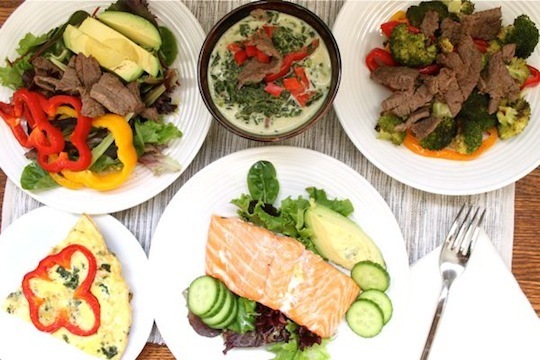 Preparing a healthy breakfast, lunch, and dinner seven days a week while living a busy life isn’t easy. Even when you know how to cook and what to eat (meat, fish, fowl, eggs, veggies, fruits, nuts and seeds) it’s still a challenge to come up with a variety of tasty meals. The best approach is to plan ahead at the start of each week so you can make one shopping trip for many meals. But who actually has time to plan ahead?
Preparing a healthy breakfast, lunch, and dinner seven days a week while living a busy life isn’t easy. Even when you know how to cook and what to eat (meat, fish, fowl, eggs, veggies, fruits, nuts and seeds) it’s still a challenge to come up with a variety of tasty meals. The best approach is to plan ahead at the start of each week so you can make one shopping trip for many meals. But who actually has time to plan ahead?
This week, it’s done for you. Below are five recipes that can be hammered out in a total of 35 minutes of focused cooking. All the planning is done for you; just shop and set aside some time in the kitchen. You’ll be rewarded five days straight when you open the fridge and a meal is waiting for you.
Now, imagine a world where a weekly guide to breakfast, lunch, dinner and snacks simply appears in your inbox. Every week you’ll know what to buy in one shopping trip and exactly how to turn all the ingredients into easy Primal meals. That world can be yours with the new Primal Blueprint Meal Plan. Subscribers will receive weekly meal plans, shopping lists and recipes to take the guesswork out of eating Primal. The recipes are easy to prepare and often provide leftovers to save you time in the kitchen.
Whether or not you decide the Meal Plan is right for you, give the recipes below a try. Set the timer and challenge yourself to cook all five meals within 35 minutes. You’ll be glad you did. Now, if only we could help with kitchen clean-up too….
Notes:
Each recipe serves two people. If you are serving more or fewer people adjust the shopping list and ingredient quantities accordingly.
Provided below are cooking instructions for preparing all five recipes at once, and cooking instructions for preparing each of the five recipes individually.
Shopping List by Item
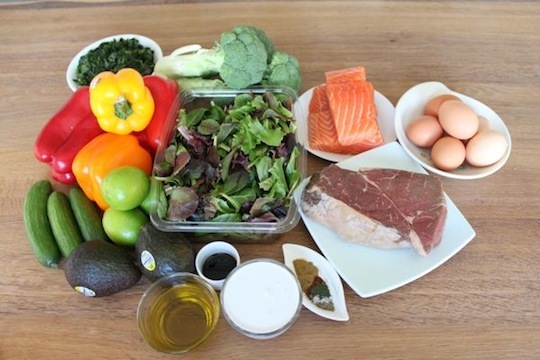
Meat:
1 1/2 pounds boneless beef (tenderloin, sirloin, flank steak, strip steak) (680 g)
4 salmon fillets (6 ounces and about 1 inch thick) skinned. To save time, ask the fish monger to do this for you. (170 g, 2.5 cm)
Produce:
4 bell peppers (red, yellow and/or orange)
1 head of broccoli
1 large cucumber or several small Persian cucumbers
3 limes
5 to 8 ounces of salad greens (enough for 4 individual salads) (142 to 227 g)
2 avocados
Frozen:
16 ounces frozen chopped spinach (455 g)
Refrigerated:
6 eggs
Nonperishable:
1 can coconut milk (13.5 ounces/400 ml)
olive oil
salt
black pepper
powdered cumin
chili powder
dried dill
coconut aminos or tamari
Shopping List by Recipe
Steak with Creamed Spinach
8 ounces boneless beef (tenderloin, sirloin, flank steak, strip steak) (227 g)
8 ounces frozen chopped spinach (227 g)
1 can coconut milk (13.5 ounces/400 ml)
1 bell pepper (red, yellow or orange)
1 lime
olive oil
salt
Steak Salad
8 ounces boneless beef (tenderloin, sirloin, flank steak, strip steak) (227 g)
1 bell pepper
4 to 6 ounces of salad greens (enough for 2 individual salads) (113 to 170 g)
powdered cumin
chili powder
1 lime
olive oil
salt
1 avocado
Steak Stir-Fry
8 ounces boneless beef (tenderloin, sirloin, flank steak, strip steak) (227 g)
1 bell pepper (red, yellow or orange)
1 head of broccoli
olive oil
salt
pepper
coconut aminos or tamari
Salmon Salad
2 salmon fillets (4 to 6 ounces and about 1 inch thick), skinned (113 to 170 g and 2.5 cm)
1 large cucumber or several small Persian cucumbers, sliced into rounds
4 to 6 ounces of salad greens (enough for 2 individual salads) (113 to 170 g)
1 lime
olive oil
salt
1 avocado
Salmon Frittata
2 salmon fillets (4 to 6 ounces and about 1 inch thick), skinned (113 to 170 g and 2.5 cm)
1 bell pepper
8 ounces frozen chopped spinach (227 g)
6 eggs
salt
pepper
dried dill
olive oil
Main Tools to Have Ready
3 rimmed baking pans
1 or two cutting boards
Sharp knives for cutting veggies and raw beef
12-inch or larger skillet (30 cm)
10-inch oven-proof skillet (to make a frittata) (25 cm)
8-inch or larger pot (20 cm)
Cooking Instructions for 5 Meals in 35 Minutes
Preheat oven to 450 ºF (232 ºC).
Take the frozen spinach out of the freezer and the meat and salmon out of the refrigerator.
Thinly slice bell peppers and place in a rimmed baking pan.
Cut broccoli into small florets and place in a rimmed baking pan.
Toss both the peppers and broccoli liberally with olive oil.
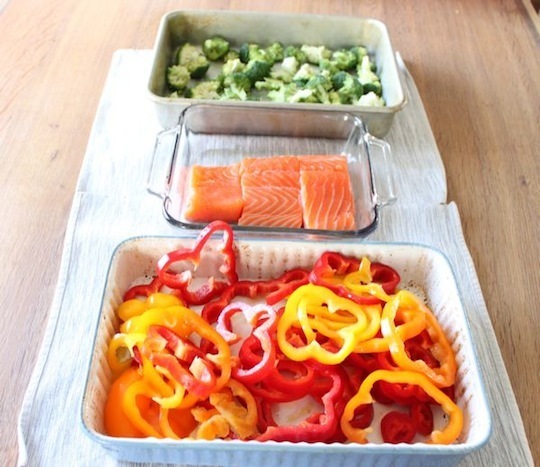
Put both pans in the oven.
Season the salmon lightly with salt and pepper. Place in a baking pan and put in the oven. Set a timer for 12 minutes; this is a reminder to take the salmon out. When you take the salmon out, leave the veggie in the oven.
Once the salmon is in the oven, slice the cucumber and set aside.
Juice the limes into a small bowl and set aside.
To make lime salad dressing, whisk together 3 tablespoons (45 ml) of lime juice, 1/2 cup (125 ml) of olive oil and 1/4 teaspoon (1 ml) of salt. Set aside. (Don’t discard remaining lime juice.)
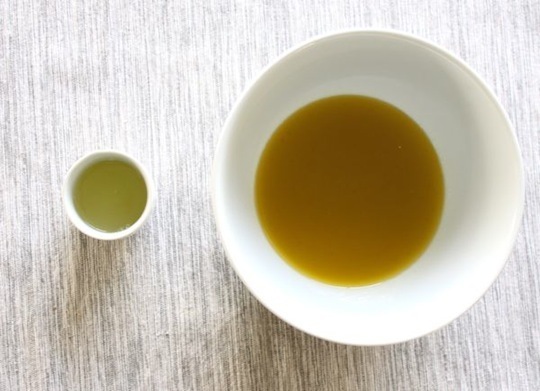
Slice the beef very thinly into 1 to 2 inch long (25 to 50 cm) slices. Lightly season with salt and pepper.
Check the salmon – is it done?
Set a 12-inch skillet (30 cm) and an 8-inch pot (20 cm) over medium-high heat. Add about a tablespoon of olive oil to each. When the oil is hot, add 2/3 of the sliced meat to the 12-inch skillet and the rest to the 8-inch pot.
Cook the meat, stirring only once or twice, until it’s cooked through to medium-rare, about 3 minutes.
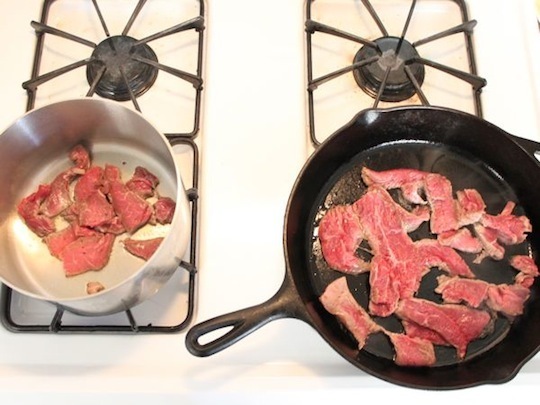
Turn the heat off under the 12-inch skillet.
To the 8-inch pot with meat, add half the frozen spinach and the can of coconut milk. Bring to a boil for five minutes then turn off the heat under the pot.

Take the broccoli and red peppers out of the oven. Turn the oven off and turn on the broiler.
Use a fork to flake two of the salmon fillets into small pieces.
Whisk the eggs together really well in a bowl. Add a pinch of salt, pepper and dried dill.
Warm a few tablespoons of olive oil in a 10-inch skillet (25 cm) over high heat.
Add the remaining frozen spinach and sauté for 3 to 5 minutes (there should be very little or no liquid in the pan).
Add the flaked salmon. Stir well then pour in the eggs and stir once to evenly spread the egg around.
While the eggs begin to set, place a few red pepper slices on top. Put the skillet in the oven. Cook the frittata under the broiler for 3 to 5 minutes until the egg sets and is firm.
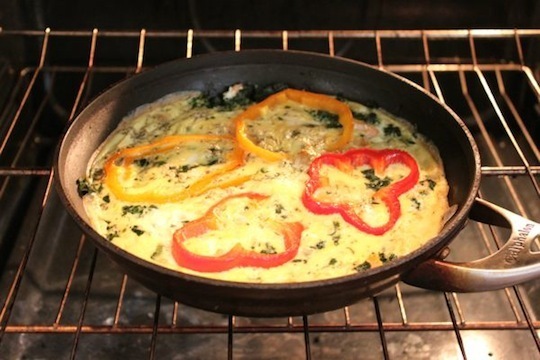
Finishing Instructions:
Steak with Creamed Spinach: Roughly chop several slices of roasted red pepper. Add them to the pot of steak and coconut milk. Season with lime juice, salt and pepper.
Steak Salad: Place beef slices and 1/2 of red peppers over mixed greens. Lightly season the salad with a few pinches of cumin and chili powder. Right before eating add 1/2 of a sliced avocado to each salad and lime dressing.
Steak Stir-Fry: Toss remaining steak slices with broccoli and red peppers. Season lightly with coconut aminos or tamari.
Salmon Salad: Set each of the two remaining fillets over several handfuls of salad greens. Garnish with cucumber slices. Right before eating add 1/2 of a sliced avocado to each salad and lime dressing.
Salmon Frittata: Slice to eat, hot or cold. Serve over a bed of salad greens if desired.

Individual Recipes
Beef with Creamed Spinach
Serves: 2
Time in the Kitchen: 25 minutes
Ingredients:
8 ounces boneless beef (tenderloin, sirloin, flank steak, strip steak) (227 g)
1 tablespoon olive oil or coconut oil
8 ounces frozen chopped spinach (227 g)
1/2 a bell pepper, thinly sliced
1 can coconut milk (13.5 ounces/400 ml)
1 lime, juiced
Pinch of salt
Pinch of black pepper
Instructions:
Slice the beef very thinly into 1 to 2 inch (25 to 50 cm) long slices.
Lightly season with salt and pepper.
In a wide skillet or pot heat a tablespoon of oil.
When the oil is hot add the beef. Cook the meat, stirring only once or twice, just to brown the outside, about 1 to 2 minutes.
Add the spinach. Cook until soft then add the bell pepper and coconut milk.
Bring to a boil for five minutes then turn off the heat under the pot.
Season with lime juice, salt and pepper.
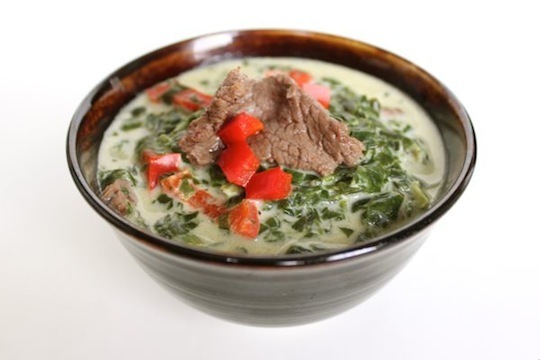
Steak Salad
Serves: 2
Time in the Kitchen: 20 minutes
Ingredients:
8 ounces boneless beef (tenderloin, sirloin, flank steak, strip steak) (227 g)
1 tablespoon (15 ml) plus 1/2 cup olive oil (125 ml)
1 bell pepper, thinly sliced
4 to 6 ounces of salad greens (enough for 2 individual salads) (113 to 170 g)
Pinch of powdered cumin
Pinch of chili powder
3 tablespoons lime juice (45 ml)
1/4 teaspoon salt (1 ml)
1 avocado, sliced
Instructions:
Slice the beef very thinly into 1 to 2 inch (25 to 50 cm) long slices.
Lightly season with salt and pepper.
In a wide skillet heat a tablespoon of olive oil.
When the oil is hot add the beef. Cook the meat, stirring only once or twice, until it’s cooked through, 2 to 3 minutes. Set the meat aside in a large bowl.
Add the bell pepper to pan (with a little more oil if needed) and saute for just a few minutes. Toss the bell peppers with the meat, along with the salad greens. Season the salad lightly with cumin and chile powder.
To make lime salad dressing, whisk together the remaining 1/2 cup of olive oil with the lime juice and salt.
Dress the salad and add avocado.
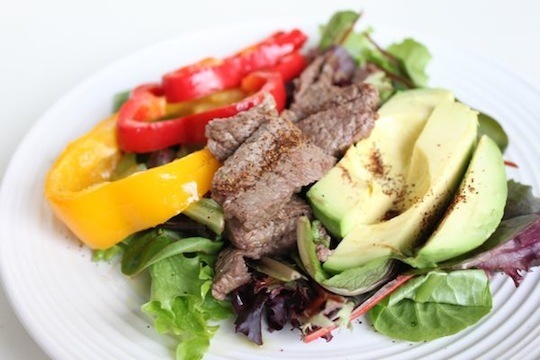
Steak Stir-Fry
Serves: 2
Time in the Kitchen: 35 minutes
Ingredients:
2 bell peppers, thinly sliced
1 head of broccoli, cut into small florets
Several tablespoons of olive oil
8 ounces boneless beef (tenderloin, sirloin, flank steak, strip steak) (227 g)
Salt
Pepper
Coconut aminos or tamari
Instructions:
Preheat oven to 450 ºF (232 ºC).
Place bell peppers and broccoli in a rimmed baking pans
Toss the vegetables liberally with olive oil and put the pans in the oven. Set the timer for 20 minutes.
Slice the beef very thinly into 1 to 2 inch (25 to 50 cm) long slices.
Lightly season with salt and pepper.
In a wide skillet heat about a tablespoon of olive oil.
When the oil is hot add the beef. Cook the meat, stirring only once or twice, until it’s cooked through to medium-rare, about 3 minutes. Put the meat in a large bowl.
Toss the meat with the bell peppers and broccoli. Season with coconut aminos or tamari.
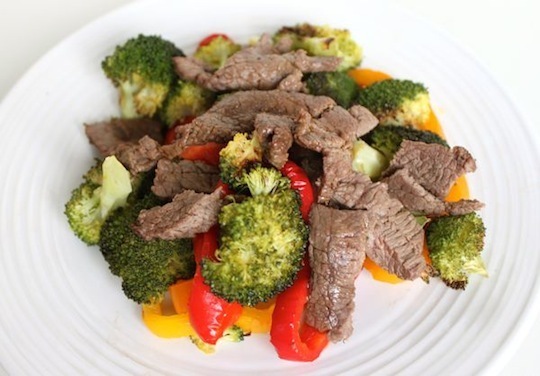
Salmon Salad
Serves: 2
Time in the Kitchen: 20 minutes
Ingredients:
2 salmon fillets (4 to 6 ounces and about 1 inch thick) (113 to 170 g and 2.5 cm)
black pepper, for seasoning salmon
1/4 teaspoon salt, plus more for seasoning salmon (1 ml)
3 tablespoons lime juice (45 ml)
1/2 cup olive oil (125 ml)
4 to 6 ounces of salad greens (enough for 2 individual salads) (113 to 170 g)
1 large cucumber or several small Persian cucumbers, sliced into rounds
1 avocado, sliced
Instructions:
Preheat oven to 450 ºF (232 ºC).
Lightly season the salmon with salt and pepper. Place in a rimmed baking pan and bake for 12 minutes, or until cooked through to your liking.
While the salmon cooks, make the salad dressing by whisking together the remaining 1/4 teaspoon salt with the lime juice and olive oil.
Toss the salad greens and cucumber slices with salad dressing. Set the salmon on top of the greens. Garnish with avocado.
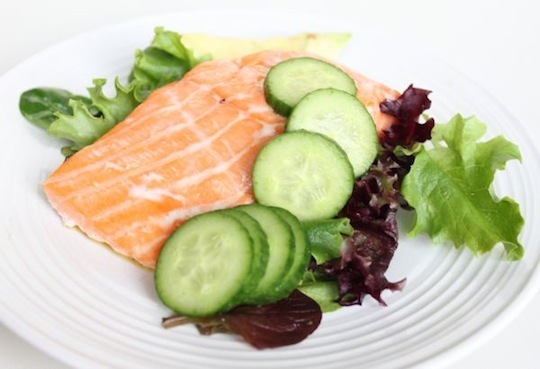
Salmon Frittata
Serves: 4
Time in the Kitchen: 30 minutes
Ingredients:
2 salmon fillets (4 to 6 ounces and about 1 inch thick), skinned (113 to 170 g and 2.5 cm)
Pinch of salt
Pinch of black pepper
6 eggs, whisked
Dried dill
2 tablespoons olive oil
8 ounces frozen chopped spinach (227 g)
1/2 a bell pepper, thinly sliced
Instructions:
Preheat oven to 450 ºF (232 ºC).
Lightly season the salmon with salt and pepper. Place in a rimmed baking pan with the red pepper and bake for 12 minutes.
When the salmon comes out, turn the oven off and turn the broiler on.
Use a fork to flake two of the salmon fillets into small pieces.
To the eggs add a pinch of salt, pepper and dried dill.
Heat olive oil in a 10-inch skillet (25 cm) over high heat.
Add the frozen spinach and saute for 3 to 5 minutes (there should be very little or no liquid in the pan).
Add the flaked salmon. Stir well then pour in the eggs and stir once to evenly spread the egg around.
While the eggs begin to set, place the red pepper slices on top. Put the skillet in the oven. Cook the frittata under the broiler for 3 to 5 minutes until the egg sets and is firm.
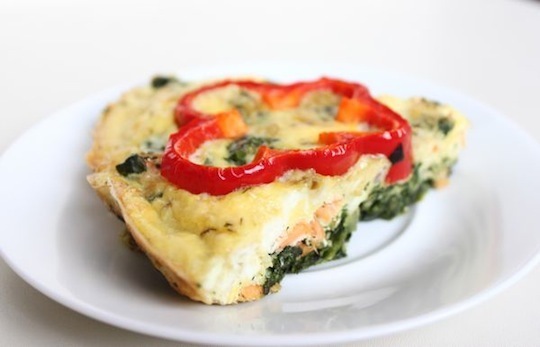
Subscribe to the Primal Blueprint Meal Plan for Meal Plans, Shopping Lists, and Recipes Delivered Directly to Your Email Inbox Every Week

Mark Sisson's Blog
- Mark Sisson's profile
- 199 followers




